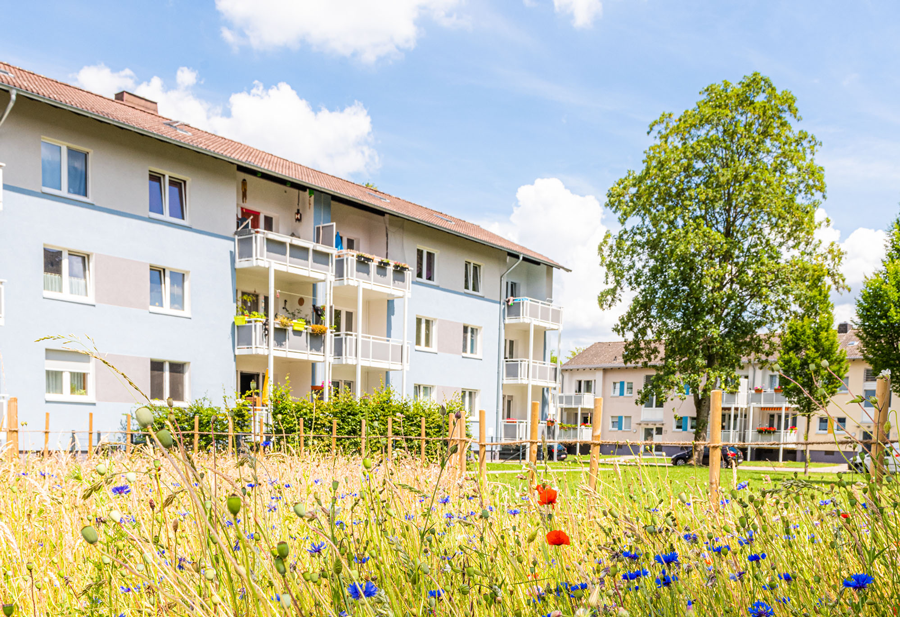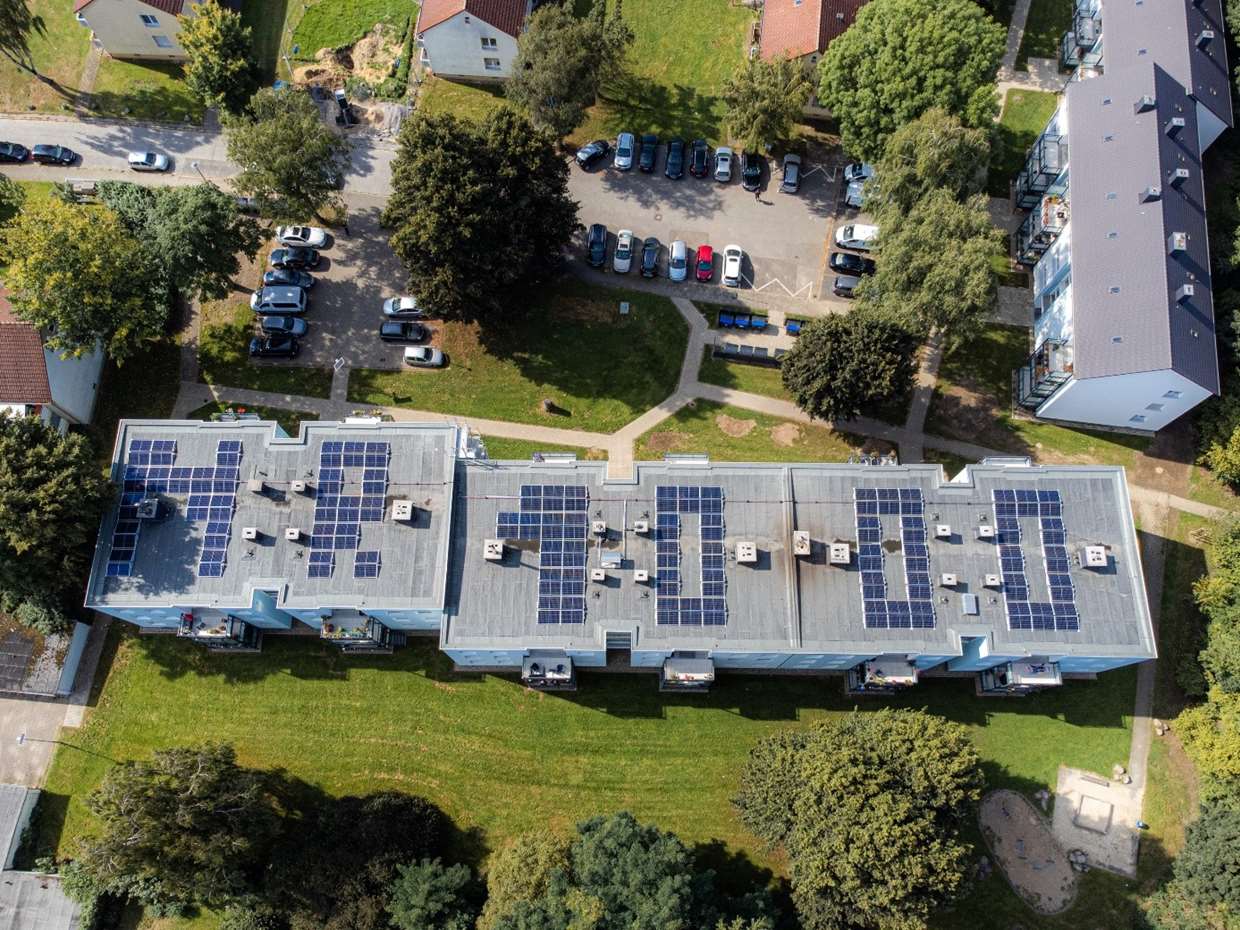Renewable Energies and Energy Mix
GRI
103-1
103-2
103-3
302-4
Our Approach
We take a two-pronged approach to achieving our climate objectives: in addition to using energy efficiently and reducing energy consumption (see Reducing CO2 in the Real Estate Portfolio/Energy-efficient Modernization), we are also committed to expanding our use of renewable energy. Our holistic and neighborhood-based approach will play a significant role in the success of this strategy due to long-term synergy effects and an expanded package of measures. A major lever that can be used to reduce greenhouse gas emissions is the expansion of renewable sources of energy. That is why we see our residential neighborhoods as the linchpin of a decentralized energy revolution. We want to implement innovative methods of generating renewable energies and actively promote their use in our own properties, especially at a neighborhood level. We want to continuously increase the proportion of renewable energies being consumed and generated. We want to do this by making greater use of hybrid heating systems, expanding heat pumps and photovoltaic systems, solar thermal systems, pellet heating and integrated neighborhood systems, which will link these technologies to each other as well as to storage technologies, in order to serve buildings in groups instead of individually. We are also piloting innovative approaches such as the use of hydrogen technology in combination with electricity from renewable sources.
One of the most important ways in which we contribute to the decentralized supply of renewable energies is by installing PV systems on the roofs of our properties. We will significantly increase our generation capacity over the next few years. We also aim to install photovoltaic systems on all suitable roofs. In light of the increasing regional demand for photovoltaic systems, we have included expanding our use of photovoltaic systems as a key measure of the performance of our regional managing directors.
Photovoltaik Plants Installed
We are convinced that innovation and developing new solutions have a crucial role to play in our ability to achieve objectives in the area of Climate and Energy. We have such a strong focus on innovation and research because because we believe that reducing the carbon emissions of our buildings to zero will not be possible or economically viable simply by implementing energy-efficient refurbishments of building envelopes and using existing technology (see Vonovia Innovation Platform).
Vonovia enables its own tenants to buy certified electricity from renewable energy sources via its own energy service company (VESG) so that they can reduce their carbon footprint. In the medium and long term, Vonovia is counting on implementing concepts for supplying energy to its own buildings. Our objective is to maximize the share of energy we produce ourselves for the benefit of our customers and the environment, and also to use it for our housing-related services, e.g., e-mobility. This will also reduce the amount of resources that we consume by simplifying our accounting and administrative processes, consolidating procedures and reducing the workload for employees.
Our plan in Austria involves supplying heat from sustainable energy sources from the public supply network (e.g., district heating in Vienna). We are focusing on an energy mix that includes a significant proportion of renewable energy sources. Wherever possible, we want to provide a way for buildings to generate their own power. We want to avoid changes at a later date as this could involve additional switching costs for residents. This will also ensure that our apartments stay attractive and above all affordable over the long term.
The switch to renewable energy is also fully underway for our portfolio in Sweden. We also have set ourselves a target of reducing energy consumption per square meter by 30% by 2030, compared to 2015 levels. In the future, all of our new buildings will perspectively be certified in accordance with the Miljöbyggnad Silver Standard of the Swedish Green Building Council to ensure a consistently high level of energy efficiency and work together with local energy providers to identify potential savings.
Organizational Focus
All activities relating to renewable energies and energy distribution in Germany are organized in the Value-add business area and are managed by a chief representative who reported directly to the CEO of Vonovia SE until the end of the 2021 fiscal year. This responsibility moved to the Chief Transformation Officer (CTO) with effect from January 1, 2022. Energy sales, through which our customers can sign green electricity contracts directly with Vonovia, are handled through the company’s own Vonovia Energie Service GmbH (VESG). The PV program and other innovative approaches aimed at the carbon optimization of the real estate portfolio as part of the neighborhood concept are developed and managed by the Innovation & Business Building department.
Business operations in Austria are the responsibility of the Chief Development Officer (CDO) and Managing Directors under the umbrella of BUWOG. All sustainability-related measures (for both new construction and the existing portfolio) are developed and managed by the Development and Property Management divisions.
The Division Heads of Victoriahem in Sweden are responsible for planning and installing photovoltaic systems on the roofs of buildings in the company’s portfolio. The head of the Energy and Environment department and the respective team support this process by providing technical advice and calculating savings in partnership with the Business Controller. The Head of the Energy Management team reports to the COO.
Objectives & Measures
One of the milestones along the path to making our portfolio climate neutral is reducing the carbon intensity of the Vonovia building stock to 25 kg CO2e per m2 of rentable area by 2030 and to increase the share of renewable energy sources (see Reducing CO2 in the Real Estate Portfolio/Energy-efficient Modernization). Expanding use of photovoltaic systems is one of the measures that we are using to achieve this objective. After focusing our efforts on drawing up plans and running trials in 2020, the reporting year was all about scaling up. We achieved our objective of setting up photovoltaic systems on 1000 flat roofs last year (see project box “Landlord-to-Tenant Electricity From 30,000 Roofs”). We want to install photovoltaic systems on 17,000 roofs by 2030 in order to harness the considerable potential of suitable roof areas. This is equivalent to an installed output in excess of 200 MWp (compared to 16.8 MWp in 2021). In order to achieve this goal, we are also investing in in-house installation capacities and creating about 100 new jobs. By 2050, we intend to fit all 30,000 suitable roof spaces in the German portfolio with PV panels. Looking ahead - as soon as the legal context provides the opportunity/the realm - the plan is to perspectively use the energy generated directly as landlord-to-tenant electricity in the individual neighborhoods as soon as the overall legal conditions make this commercially feasible. The first such efforts were started in the year under review.
However, the decentralized energy supply strategy is reliant on some external factors. Our efforts to expand our use of photovoltaic systems in the reporting year were slowed by supply bottlenecks that affected materials like solar modules and meter boxes. The skills shortage also had an impact, as we found when we were unable to meet our need for electricians (see Corporate Culture and Employees). We continued the time-consuming process of fostering expertise internally in response to the skills shortage in 2021. We plan to press ahead with these measures on the basis of our insourcing strategy in 2022, with the goal of carrying out the work through our own craftsmen’s organization.
We are expanding our activities as an energy services provider because the ability to generate and supply energy on a decentralized basis play a key role in the energy revolution. We supplied green power to around 25,000 customers in 2021 through our energy distribution company VESG (Vonovia Energie Service GmbH). Our focus in terms of energy generation is on promoting networked neighborhood systems and sector coupling. This involves linking the electricity, heating and mobility sectors so that the electricity generated locally and the heat generated can be used for the apartments – turning our neighborhoods into efficient small power plants (prosumers). We are also piloting innovative approaches, such as a wide variety of storage systems – with a particular focus on the short-term and seasonal storage of energy – and maintained our partnerships with a variety of scientific institutions and partners during the reporting year. We opened the Power House of the Future project in April 2021 in Bochum-Weitmar with the aim of researching innovative energy systems and implementing them in practice. The project will also provide vital information and data that will be used to develop and scale technologies. Innovative technologies, including an electrolyzer that uses electricity to produce hydrogen, fuel cells, heat pumps and stratified storage that cover at least 60% of the heating needs of buildings and households in the area with carbon-free heat from a local source. We generate 25% of the power required locally using our own rooftop photovoltaic systems. As part of another research project in Bochum-Weitmar, we are developing an innovation neighborhood with a focus on climate change mitigation in partnership with scientists from a number of different Fraunhofer Institutes and Ampeers Energy GmbH. This project is funded by the state of North Rhine-Westphalia.
Linking local energy management systems together in an intelligent way also includes e-mobility approaches. We are still working on the development of a range of scalable mobility concepts and solutions for needs-based charging infrastructure. Since each neighborhood is unique and has its own features and requirements, we are developing the concepts in such a way that the regions can use them as they see fit. One core element of our research and development work in this area is the expansion of charging infrastructure. The plan is for tenants with their own parking space to get a wallbox on request and pay for their electricity through Vonovia.



